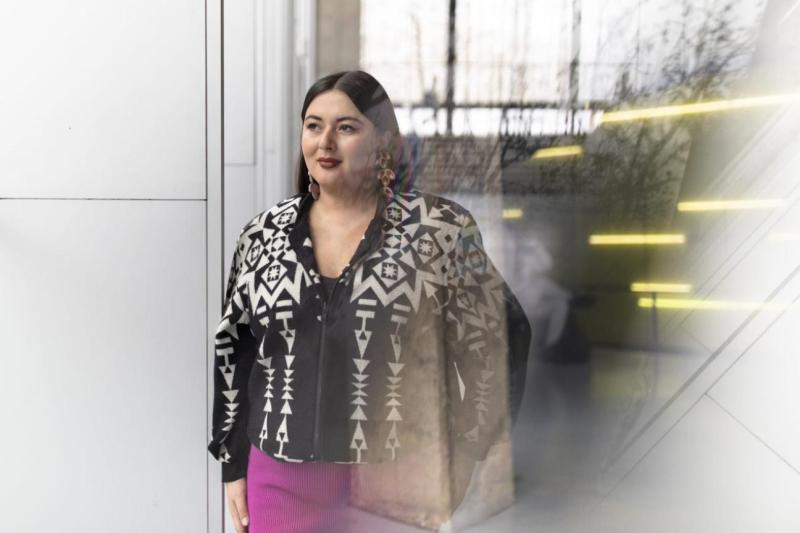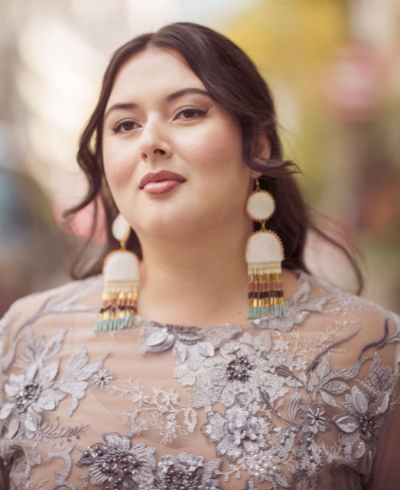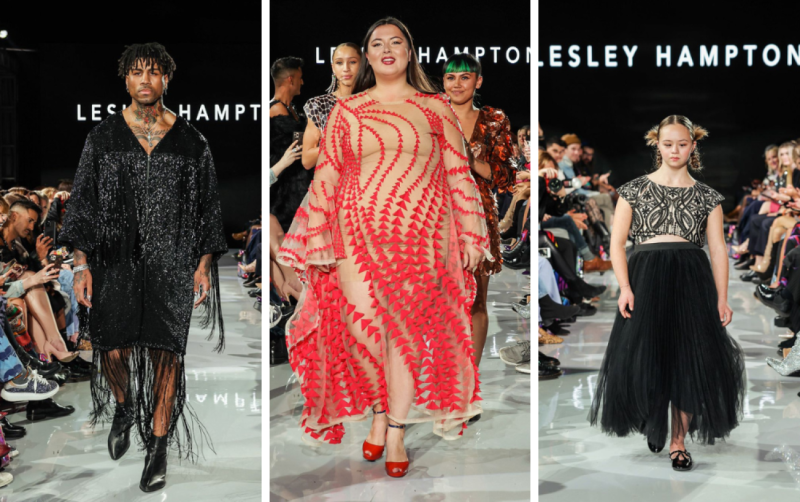December 1, 2022 | Alumni
This U of T Mississauga alumna is championing diversity in the fashion world
By Tara Clemens

Lesley Hampton visiting the U of T Mississauga campus. Photo by Nick Iwanyshyn.
An Anishinaabe artist, designer, model and passionate advocate for inclusivity, mental wellness, and authentic representation, Lesley Hampton (HBA 2015 UTM) is on a mission to disrupt the mainstream fashion world.
Since graduating from U of T Mississauga, she has launched her very successful Lesley Hampton brand, named by VOGUE Magazine as the “number one Canadian brand to keep your eye on.” Following her recent show at Fashion Arts Toronto, Lesley talked with us about challenging established norms and becoming a champion for inclusivity and diversity in the fashion industry.
You’ve described your childhood as nomadic. How do you feel that impacted you in your formative years?
I always say that I live at the intersection between my third culture upbringing and my Indigeneity, because I am Anishinaabe, but I didn't grow up on a reservation. I was born in Newfoundland, but ended up moving throughout my youth every two and a half years until age 18. Growing up I spent time in Calgary, the Northwest Territories, and then internationally in Australia, New Caledonia, Indonesia and England. I have the culture and blood memory of being an Indigenous person and take on those attributes, but also those international experiences from my formative years shaped me into a lifelong learner who understands these different communities, environments and different ways of living. It definitely allowed me to have a greater level of understanding when it comes to diversity and inclusivity.
What sparked your interest in the fashion world?
I learned how to sew when I was only four years old, and while I wasn’t good by any means, I was definitely interested from a young age. My mom was into quilting, so we always had a sewing room in our house no matter where we moved. I always had a space I could go to, to be creative, and that definitely impacted me a lot, just to have that creative outlet space. In school I always gravitated towards the arts. I did an International Baccalaureate program in high school and art was definitely my favourite class. I love not only making the art, but understanding the concept behind it, and that really pushed me forward into a creative direction.
Specifically, my interest in fashion began by watching Jeanne Beker on Fashion Television. At the time I was living in Newfoundland and that was really the only way to reach the fashion industry. I loved watching the designers on the runway, and the amazing blend of design, art and performance. But then being an Indigenous person, and feeling different than my friends at school, I never really saw myself being a part of that world. I feel like I just gave it a shot and it seems to have worked out so far.
What did you take from your studies that prepared you for this journey?
The Art & Art History program that I studied at UTM really trains you conceptually to understand why you're making the art you're making, and then taking that knowledge and presenting your work during class critiques. My favourite class was Art Since 1945 (FAH289H5) because I got to really understand the contemporary world. I remember I wrote an essay on Kim Kardashian and the paparazzi that I loved. I think it was the mix between the studio and the classroom, and having that conceptual basis for the art; seeing how other creatives critique your work and thinking of all the different ways that people could approach my art.
When I transitioned to fashion, it was that underlying basis of knowing what I wanted to say with my work. Maybe the work wasn’t up to par because I was newer to sewing in my early collections, but I always had that underlying concept. There’s been times for collections that I’ve written pages about all the things I wanted to convey, and honestly that’s really a nod to my art history background.
You started your lesley hampton brand right after graduating. Did you always have a clear vision for it?
Yes, right from the beginning! I always wanted it to be inclusive. I knew that I wanted to bring all different body types, abilities and skin colors to the runway. With my first show, I was able to cast it myself, so that’s exactly what I did. It was just so important for me to bring different representations of Canadian society to the runway, and I think that's really something that stayed with me to this day. Since that first show, and since further developing what I want to say in fashion, our Lesley Hampton brand pillars have become body positivity, mental health awareness, and authentic representation. And that third one is because, being an Indigenous person in fashion, you get a lot of stereotypes applied to you when you try to go the mainstream route. During Fashion Weeks, the media would ask me certain questions that weren’t really appropriate. It was through those interactions that I really wanted to bring an authentic representation of Indigenous people to the top of my platform so that people can see that we’re not what you saw in textbooks. We are much more multifaceted.

how do you champion body-positivity in a fashion world that idealizes Eurocentric beauty standards?
We have a lot of wins because it's something that unfortunately is always a speaking topic. But I’d prefer to highlight the good things, like the messages or comments that we receive by email or on Instagram from people who have seen their body shape represented in our fashion, and how much that puts a smile on their face, and gives them the power to wear the dress or do the thing. That's really so exciting for me. I always say my favourite thing about fashion is when I'm with a client and they put on the dress, and they love how it fits, and they love how it looks. They feel that way because it was made for them and not made for, say a smaller body, and then sized up incorrectly, because no one's taught how to design for plus size. That's definitely so exciting for me when I can see those smiles! But to this day, and even with how much we put out into the world that we are size-inclusive with our branding, I still have to argue with certain casting directors to represent my work and the way that I've created it correctly, and not to try to put it on a smaller body.
At your Fashion Art Toronto show, your runway included models from the BIPOC and LGBTQ2S+ community and individuals with disabilities. Why is this kind of representation so important to you?
I see representation as a form of harm reduction. I know from personal experience, and from talking to friends and people in the industry, that we try so hard to fit into a status quo that the mainstream fashion industry tells us we should fit into. But when we don’t fit, then it causes a lot of harm, and ultimately that comes down to the decisions of the designer, or the creative director, or the media outlet. These decision-makers in the fashion industry are given this platform, and ultimately this responsibility to make a change. A few people have made the decision to try and change this mentality and understand how important representation really is. It is so crucial for our mental health to lower the harm that we apply to ourselves, either physically or mentally. I see there being such a direct relation between mental health and clothing, because we interact with clothing every day, and our mental health and body image is connected to the implications of that experience.
what does authentic representation mean to you?
Authentic representation is making that decision to include someone with a difference. It’s not tokenism, and it's not just checking a box. It's because you truly believe that their inclusion will make a change and make a difference. It's seeing yourself represented in a space, and taking up that space proudly. You see an individual who empowers you, and that allows you to come into your own power and take on the day.
What is next for you?
An ongoing challenge for me personally is always balancing my personal life with my business life. Pre-pandemic, that is something that I honestly wasn't the best at doing. I was working so hard, always trying to build my brand up, and it did take an impact on my mental health. Now I’m kind of reintroducing myself post-Covid to the fashion world. Having that work-life balance is so crucial for me, and that's something that is an ongoing process. I always say that my business isn't going to thrive unless I'm thriving. I definitely credit the recent growth the brand has had to the efforts that I put forward into bettering my mental health. It allows me to work better and to feel more capable to take on all of these difficult things within the fashion industry.
On a professional level, I am so excited to join the Indigenous Fashion Arts Trade Program in Milan, Italy in February to present our new collection. That will be the first time we’re bringing our work to Europe since we attended London Fashion Week back in 2018. It’s been a long time coming to be able to travel again with my work, so that’s going to be a really exciting experience to work with buyers. It will be happening during Fashion Week so that’s going to be massive for the brand, and for the group of Indigenous brands that are going to that event as well. I’m just hoping to expand the brand internationally as much as I can. I’m very excited to see where I can push inclusive representation in fashion through the work we’re doing.


